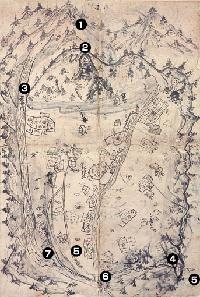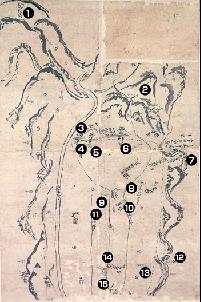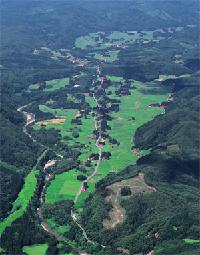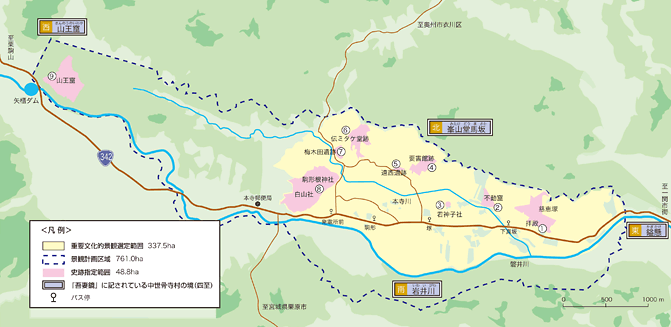Depictions of a Medieval Village(「描かれた中世の村」大石 直正 著)
Illustrated Maps of Honedera Village, an Estate of Chūsonji Temple
These maps do not have titles, so I shall call them together the “illustrated maps,” or just the “maps” as appropriate. When necessary, to distinguish between them I shall refer to one as the “household map” and the other as the “shrines and temples map.” The household map depicts the homes and paddies of Honedera in greater detail than the shrines and temples map because such maps were used for tax assessment purposes. The latter, though overall more simplified, supplies much greater detail on the mountains around the village, and also the paddies set aside for the valley’s religious facilities.
 Illustrated map of households in Honedera. 84.5cm×57.2cm. Four connected sheets. West at top. Finely detailed black-and-white illustration from the early Kamakura period (1192-1333). (1)駒形 (Komagata), (2)山王石屋 (Sannō no Iwaya), (3)石ハ井河 (Iwaigawa River; now磐井川), (4)大師堂 (Taishidō), (5)馬坂新道 (Masaka Shindō), (6)鎰懸 (Kagikake), (7)古道 (old road). Map from collection of Chūsonji Temple. Photograph courtesy of author.
Illustrated map of households in Honedera. 84.5cm×57.2cm. Four connected sheets. West at top. Finely detailed black-and-white illustration from the early Kamakura period (1192-1333). (1)駒形 (Komagata), (2)山王石屋 (Sannō no Iwaya), (3)石ハ井河 (Iwaigawa River; now磐井川), (4)大師堂 (Taishidō), (5)馬坂新道 (Masaka Shindō), (6)鎰懸 (Kagikake), (7)古道 (old road). Map from collection of Chūsonji Temple. Photograph courtesy of author.
 Illustrated map of shrines and temples in Honedera. 84.7cm×54.8cm. Four connected sheets. West at top. Mostly simplified black-and-white illustration, with exception of realistically detailed northern mountains. Believed older than household map. (1)駒形根 (Mt. Kurikomayama/Komagatane), (2)山王 (Sannō), (3)白山 (Hakusan Shrine), (4)寺崎 (Terasaki), (5)骨寺跡 (Site of Honedera Temple), (6)六所宮 (Rokusho no Miya)、(7)金峯山 (Mt. Kinpusen) (8)経蔵別当御休所 (Chūsonji Sutra Repository steward’s rest area)、(9)うなね(宇那根) (Unane Shrine), (10)檜山川 (Hiyamagawa River), (11)中澤 (Narazawa)、(12)慈恵塚 (Jie Mound)、(13)御拝殿 (Worship hall)、(14)若神子神田二段 ()、(15)鎰懸 (Kagikake)(中尊寺蔵、筆者写真提供)。Map from collection of Chūsonji Temple. Photograph courtesy of author.
Illustrated map of shrines and temples in Honedera. 84.7cm×54.8cm. Four connected sheets. West at top. Mostly simplified black-and-white illustration, with exception of realistically detailed northern mountains. Believed older than household map. (1)駒形根 (Mt. Kurikomayama/Komagatane), (2)山王 (Sannō), (3)白山 (Hakusan Shrine), (4)寺崎 (Terasaki), (5)骨寺跡 (Site of Honedera Temple), (6)六所宮 (Rokusho no Miya)、(7)金峯山 (Mt. Kinpusen) (8)経蔵別当御休所 (Chūsonji Sutra Repository steward’s rest area)、(9)うなね(宇那根) (Unane Shrine), (10)檜山川 (Hiyamagawa River), (11)中澤 (Narazawa)、(12)慈恵塚 (Jie Mound)、(13)御拝殿 (Worship hall)、(14)若神子神田二段 ()、(15)鎰懸 (Kagikake)(中尊寺蔵、筆者写真提供)。Map from collection of Chūsonji Temple. Photograph courtesy of author.
What is Depicted
The area included in both maps corresponds to the Hondera area of modern Ichinoseki City, Iwate. (Note that the pronunciation has changed from the medieval “Honedera” to contemporary “Hondera.”) This settlement is 16km west of central Ichinoseki on National Road 342, past the famous Gembikei Gorge but along the same Iwaigawa River.
 Aerial photo of Hondera, Genbichō, Ichinoseki, Iwate. West at top, National Rd. 342 in center, Iwaigawa River at left. River at right (north) between mountains and National Rd. is Honderagawa. (Photo courtesy of Kawashima Printing Co., Ltd.)
Aerial photo of Hondera, Genbichō, Ichinoseki, Iwate. West at top, National Rd. 342 in center, Iwaigawa River at left. River at right (north) between mountains and National Rd. is Honderagawa. (Photo courtesy of Kawashima Printing Co., Ltd.)

Environs of illustrated maps. The farmland of medieval Honedera was located along the Iwaigawa banks and centered on the Honderagawa riverside. The area south of the National Road was not farmed extensively. The distance between the farmed plains and Sannō no Iwaya in the illustrated maps is greatly reduced, suggesting the area was not farmed.
In the upper map, notice the string of toponyms: 本寺 (Hondera), 駒形 (Komagata),要害 (Yōgai), 沖要害 (Okiyōgai), 若神子 (Wakamiko), 下真坂 (Shimomasaka) along the north bank of the Iwaigawa River. In the midst of all this is a flat area in which the Honderagawa, a small river, runs. This is the arable flatland in the illustrated maps. Both maps are oriented with west at the top, and in both the Honderagawa is visible flowing from top right (northwest) to bottom left (southeast), though in the shrines and temples map the river is labeled檜山川 (Hiyamagawa) and is drawn with just two simple strokes.
These maps show the fusiform (spindle-shaped) valley topography stretched north-south into a rectangle. Though not an “accurate” representation, it is a clever method of picturing the entire Honedera village on rectangular paper.
Near the top of the map and a bit farther to the west is Mt. Sannōyama, location of the cave (iwaya, 岩屋 or 窟) called Sannō no Iwaya ((2)山王石屋) in the top-center of the household map. A notation for 山王 (Sannō) can be found in the shrines and temples map as well, but this is a later addition. This map is actually missing its original upper eighth or so, in which Mt. Sannōyama was originally drawn. The smaller note was added to replace that in the lost portion.
Both illustrated maps significantly compress the distance between the village plains and Mt. Sannōyama. They also both place Mt. Kurikomayama, which straddles the modern Miyagi-Iwate-Akita tri-prefectural border, at the top of the map, though in the household map it is labeled Komagata (駒形) and in the shrines and temples map Komagatane (駒形根). In fact, the distance from Hondera to the peak of Kurikomayama is 29km, so the maps’ depictions are also a distortion of the landscape. Such license was necessary to include in the maps the village’s sacred western peak, which can still be seen from virtually anywhere in the valley. This sacralization of Kurikomayama continues today, as the village’s present-day tutelary shrine is Komagata Shrine.

 印刷
印刷
